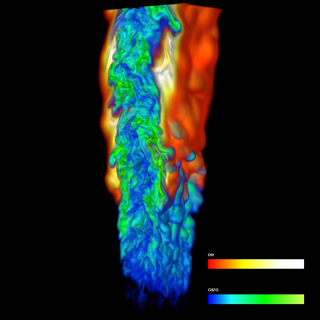
Three computationally based Sandia research projects have been awarded 73 million of 1.6 billion supercomputing processor hours offered by DOE’s INCITE program to advance cutting-edge work.
Another Sandia researcher is participating in a Los Alamos National Laboratory-led proposal that was granted 25 million hours.
The simulation shown here, using an INCITE allocation from 2009, depicts turbulently lifted ethylene-air jet flame. It was performed at the National Center for Computational Sciences/Oak Ridge National Laboratory on more than 30,000 CrayXT5 processors. The flame is denoted by hydroxyl radical (OH) shown in reddish colors. The autoignition upstream of the lifted flame is denoted by formaldehyde (CH2O) shown in bluish-green colors. Formaldehyde also appears on the fuel-rich side of the flame. The volume rendering was performed by Hongfeng Yu and Jackie Chen (8351). The simulation was performed by Chun Sang Yoo and Jackie.
Not just another meaningless acronym, INCITE (Innovative and Novel Computational Impact on Theory and Experiment program) is meant to provoke researchers into attempting new discoveries in areas as diverse as climate change, alternative energies, life sciences, and materials science.
“Computation and supercomputing are critical to solving some of our greatest scientific challenges,” said DOE Secretary Steven Chu. “This year’s INCITE awards reflect the enormous growth in demand for complex modeling and simulation capabilities, which are essential to improving our economic prosperity and global competitiveness.”
Sixty-seven million hours of computing time on Oak Ridge National Laboratory’s Cray XT were awarded to Jacqueline Chen and Joseph Oefelein (both 8351) to improve “High-Fidelity Simulations for Clean and Efficient Combustion of Alternative Fuels.” While it’s apparent that alternate fuels are moving into position to supplement gasoline, there is as yet no intimate understanding of the burning processes of these substitute fuels. Better understanding is crucial to most efficiently extracting the energy they could provide. The team will investigate turbulently reacting flow processes in an actual internal-combustion-engine geometry in actual operating conditions, as well as underlying turbulence-chemistry interactions in laboratory-scale flames. Participating in the research will be Sandia’s Jeffrey Doom, Ray Grout, Bing Hu, Guilhem Lacaze, Edward Richardson (all 8351), and Ahren Jasper and James Miller (both 8353), as well as researchers from Cornell University, the University of Minnesota, and Argonne and Oak Ridge national laboratories.
Another Sandia proposal, “Scalable System Software Research for Extreme-Scale Computing,” will be led by Ron Oldfield (1422), with coinvestigators James Laros (1422) and (all 1423) Ronald Brightwell, Kurt Ferreira, Suzanne Kelly, Kevin Pedretti, and Rolf Reisen. The project was awarded 5 million processor hours on Oak Ridge National Laboratory’s Cray XT “to significantly advance the state of the art for system software on the next generation of HPC systems.” The work will concentrate on investigating scalability issues for research in lightweight operating systems, program resilience, input/output, power efficiency, and debugging.
Ronald Minnich (8961) will lead a research group from four other institutions (Carnegie-Mellon University, Bell Labs, IBM, and Vita Nuova) to develop a new software environment for supercomputers that make each appear to be part of the user’s desktop system instead of a remote and hard-to-access external computer. Their proposal, “BG/P Plan 9 Measurements on Large Scale Systems” was granted 1 million hours on Argonne’s IBM Blue Gene/P supercomputer. Plan 9 is an operating system built with networks in mind.
Sandia researcher Mark Taylor (1433) is a coinvestigator on the LANL-led study “Numerical Study of Multiscale Coupling in Low-Aspect Ratio Rotating Stratified Turbulence” that will deal with the complicating effects on climate models of nonhydrostatic factors like local topographic features. A statistical description of these effects “would have a profound effect on our understanding of how ocean/atmosphere/climate models need to handle their fluid dynamics component, particularly when it comes to prediction of long-term phenomena . . . ” The project was granted 25 million processor hours on Argonne National Laboratory’s IBM Blue Gene/P supercomputer.